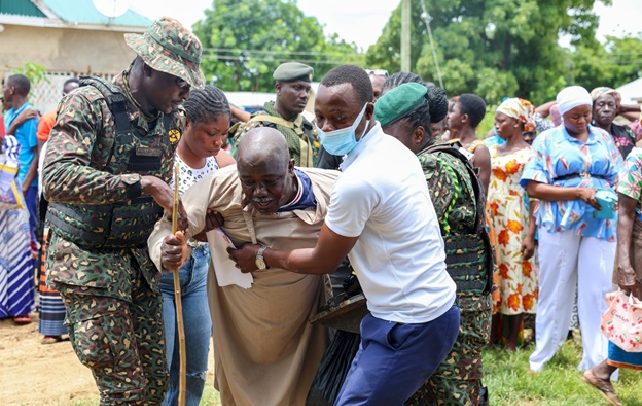IOM, Partners Hold Displacement Crisis Simulation Exercise
The lessons learned from the SIMEX will be integrated into the cross-border humanitarian crises response plan to address any identified gaps and weaknesses.
- Advertisement -
The International Organization for Migration (IOM), in collaboration with the National Disaster Management Organisation (NADMO), successfully conducted a simulation exercise (SIMEX) in Paga at the Ghana-Burkina Faso border to test the readiness and effectiveness of humanitarian responders and community preparedness in managing and responding to cross-border emergencies.
The SIMEX sought to assess coordination among various humanitarian actors and responders, evaluate the rapid deployment of Emergency Operating Centres (EOCs) and crisis management tools, identify strengths and weaknesses in actors and agencies’ responses, and strengthen relationships between governmental and non-governmental organizations.
- Advertisement -
The lessons learned from the SIMEX will be integrated into the cross-border humanitarian crises response plan to address any identified gaps and weaknesses.
- Advertisement -
NADMO Deputy Director General, Mahama Saibu Mumuni, emphasised the need for a robust cross-border humanitarian crises response plan, “Given the volatile situation in the region, having a structured and coordinated response to cross-border emergencies, is essential,” said Mr Mumuni.
“The simulation was a vital component in fine-tuning our preparedness. With events happening in the Sahel where thousands of displaced persons are crossing into Ghana to seek refuge, it is clear that an effective, well-coordinated inter-agency approach is critical for managing such situations,” it added.
The exercise was an important element to address the urgent need for a coordinated approach to managing large spontaneous influxes of displaced persons, as highlighted by recent events in the region.
For instance, in November 2020, nearly 1,000 people fled to Ghana to escape potential election-related violence in Côte d’Ivoire; and earlier this year, increased military actions in Burkina Faso caused over 4,000 Burkinabes to seek refuge in Ghana.
Such incidents underscore the importance of a coherent and coordinated inter-agency approach to responding to the needs of displaced populations and host communities, which the new cross-border humanitarian crises response plan aims to provide.
- Advertisement -
Head of the EOC for the SIMEX, Richard Amo Yartey, Director of Inspectorate at NADMO, and Gerard Ataogye, District Chief Executive for the Kassena Nankana West District Assembly, said in a joint statement, “The process is a testament to the good working relationships of all partners involved. The SIMEX showcased how crucial it is to bring together local and international actors.
This exercise strengthened coordination and fostered collaboration among all key stakeholders, from community members to security agencies and humanitarian partners. We need to sustain this level of teamwork to be fully prepared for future crises.”
The exercise brought together about 500 participants including 300 community members and 200 local stakeholders. Prior to the exercise, a series of activities including trainings for key stakeholders and for security officials, as well as community sensitisations, was carried out to prepare all parties involved.
“The successful completion of the SIMEX marks a significant step towards enhancing the capacity of Ghana and its neighbouring countries to manage large-scale population displacements effectively.
The lessons learned and feedback collected during the exercise will be crucial in refining the contingency plan and ensuring a timely and coordinated response to future humanitarian crisis that causes mass movement of populations in the region. IOM stands ready to further support the Government of Ghana to ensure the safety of its borders, its border communities as well as people on the move,” said IOM Ghana Chief of Mission, Ms. Fatou Diallo Ndiaye.
The project is realised with funding from the United States Department of State’s Bureau of International Narcotics and Law Enforcement Affairs (INL).
Source:dailyguidenetwork.com
- Advertisement -


